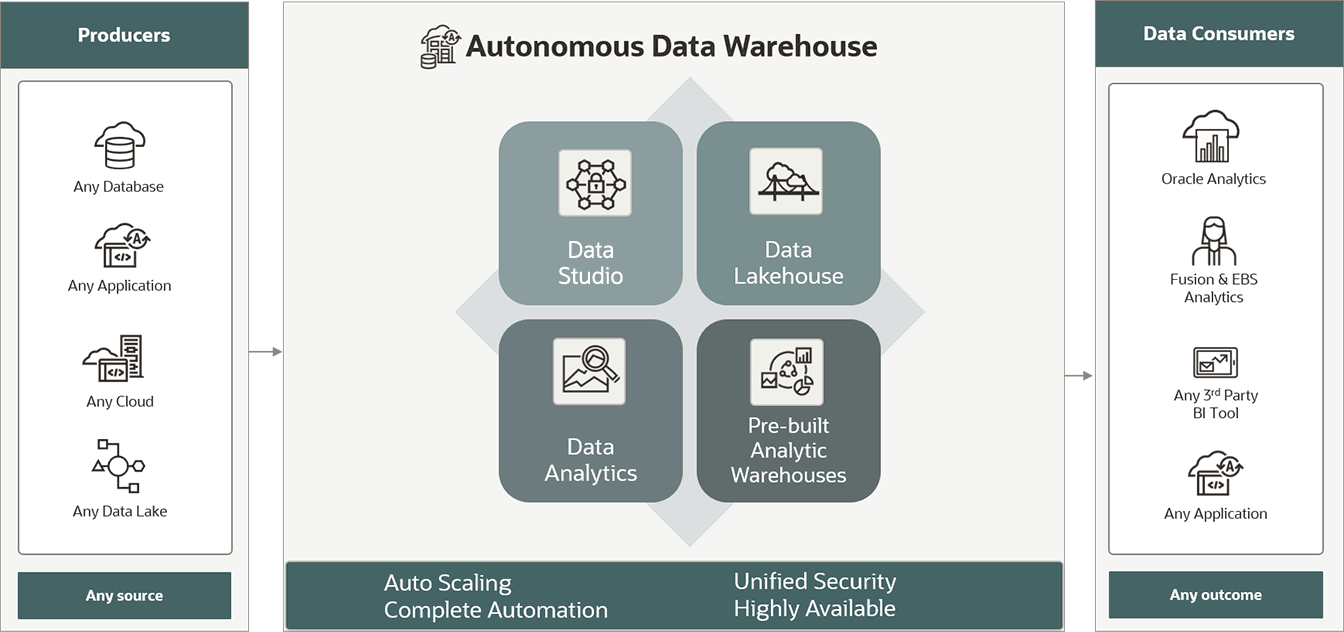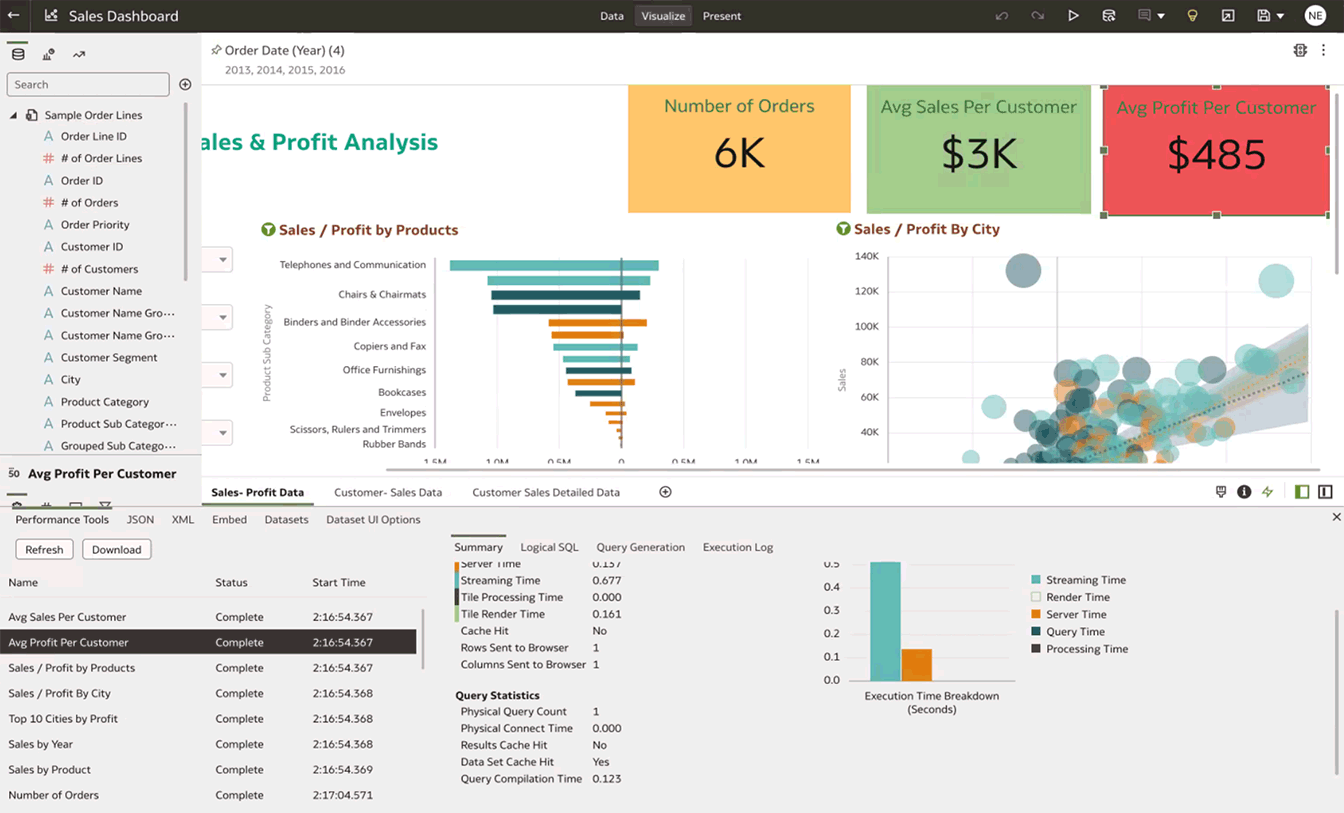Oracle Autonomous Data Warehouse
Oracle Autonomous Data Warehouse is the world’s first and only autonomous database optimized for analytic workloads, including data marts, data warehouses, data lakes, and data lakehouses. With Autonomous Data Warehouse, data scientists, business analysts, and nonexperts can rapidly, easily, and cost-effectively discover business insights using data of any size and type. Built for the cloud and optimized using Oracle Exadata, Autonomous Data Warehouse benefits from faster performance and, according to an IDC report (PDF), lowers operational costs by an average of 63%.
 Announcing generative development (GenDev) for enterprise
Announcing generative development (GenDev) for enterprise
Watch the replay of EVP Juan Loaiza’s Oracle CloudWorld keynote to learn about this groundbreaking, AI-centric AppDev infrastructure.
Why choose Autonomous Data Warehouse?
-
Reduction in financial closing time
-
Lower data administration costs
-
Faster query performance
-
Five-year ROI with five-month payback period
-
Reduction in DBA workloads for reporting
- On October 10: Learn how GenAI can supercharge your apps
Join us to hear about new ways GenDev can help you build innovative apps with AI.
- Innovate with the combined power of Oracle and Microsoft
Learn how Oracle Autonomous Database on Oracle Database@Azure offers new possibilities to run mission-critical multicloud applications.
- Omdia: Oracle swings for the fences with Autonomous Data Warehouse updates
Read the latest report from Omdia on how Autonomous Data Warehouse is disrupting the fragmented analytics data platform marketplace.
- Oracle named a Leader in Gartner® Magic Quadrant™
Gartner recognizes Oracle as a Leader in the Magic Quadrant for Strategic Cloud Platform Services.
Get more value from data and analytics
Do more using a data platform designed for speed, agility, and simplicity
Autonomous Database provides the foundation for a data lakehouse—a modern, open architecture that enables you to store, analyze, and understand all your data. The data lakehouse combines the power and richness of data warehouses with the breadth, flexibility, and low cost of popular open source data lake technologies. Access your data lakehouse through Autonomous Database using the world's most powerful and open SQL processing engine.
 Oracle’s data lakehouse platform is built from a combination of a data lake and data warehouse to form a data lakehouse. It merges data warehouse and data lake capabilities to enable easier data movement with a more unified architecture. Integrating data lake and data warehouse provides many benefits, including data management, AI and machine learning, and integration options.
Oracle’s data lakehouse platform is built from a combination of a data lake and data warehouse to form a data lakehouse. It merges data warehouse and data lake capabilities to enable easier data movement with a more unified architecture. Integrating data lake and data warehouse provides many benefits, including data management, AI and machine learning, and integration options.Analyze any data, anywhere
Autonomous Database's advanced data processing engine lets you gain insights across multicloud data sources. It doesn't matter if your data is in AWS, Azure, Google Cloud Platform, or Oracle Cloud Infrastructure object stores and databases. Or, if your data is in big data file formats such as Apache Parquet, JSON, Apache ORC, Apache Avro, CSV, or XML, Autonomous Database delivers a simple, consistent view of your data estate using your preferred SQL-based tools and applications.
 All the data ingestion, transformation and integration flows into the data stores, warehouses, and data lakes. At the very core, Oracle offers a unified, efficient, low cost and scalable place to unify all this enterprise data even though the data may sit unstructured all the way to structured and curated data. Here you can store, manage, analyze and understand all your data.
All the data ingestion, transformation and integration flows into the data stores, warehouses, and data lakes. At the very core, Oracle offers a unified, efficient, low cost and scalable place to unify all this enterprise data even though the data may sit unstructured all the way to structured and curated data. Here you can store, manage, analyze and understand all your data.Empower innovators with integrated, self-service analytics
Increase the productivity of business users by reducing their dependency on IT, using self-service data tools, and creating low-code analytic applications. Enhance collaboration across teams with Autonomous Database’s analytic views that provide common business definitions and metrics integrated with Oracle Analytics Cloud, Tableau, and other business intelligence applications. Enhance business storytelling based on all data, using the power of built-in machine learning, spatial and graph analytics, and data visualization.
 With Oracle Autonomous Database, data scientists, business analysts, and non-experts can rapidly, easily, and cost-effectively discover business insights using data of any size and type.
With Oracle Autonomous Database, data scientists, business analysts, and non-experts can rapidly, easily, and cost-effectively discover business insights using data of any size and type.Prevent risks with security assessments, auditing, and active protection
Autonomous Database provides the most advanced data security that helps reduce the risk of a data breach and simplifies regulatory compliance. Its automated self-patching, automatic, always-on encryption and key management, granular access controls, and flexible data masking provide comprehensive user behavior monitoring with sophisticated auditing capabilities.
 Evaluate the security posture of your database and receive recommendations on how to migrate potential risks.
Evaluate the security posture of your database and receive recommendations on how to migrate potential risks.Autonomous Data Warehouse features
A modern data platform for business insights
Oracle Autonomous Database plays a central role in the data lakehouse as both an analytic engine and optimized data store. Users can access the lakehouse through Autonomous Database’s powerful and open SQL processing engine. Analyze Autonomous Database data from big data frameworks using highly efficient Apache Spark and Python connectivity.
Simplified data warehouse management—with built-in automation
Autonomous management capabilities, such as provisioning, configuring, securing, tuning, and scaling, eliminate nearly all the manual and complex tasks that can introduce human error. Autonomous management enables customers to run a high-performance, highly available, and secure data warehouse while running thousands of databases with no administration.
Features- Auto-backups
- Auto-patching
- Auto-repairing
- Auto-scaling
- Auto-securing
- Auto-tuning
Ensure consistently high performance
Autonomous Data Warehouse continuously monitors all aspects of system performance. It adjusts autonomously to ensure consistent high performance even as workloads, query types, and the number of users vary over time.
Features- Auto-scaling
- Auto-tuning
- Auto-indexing
- Hybrid Columnar Compression
- Columnar processing
- Smart Scan
- Automatic optimizer statistics gathering
Reduce risk with database security
Secure Autonomous Data Warehouse with a unified database security control center that identifies sensitive data and masks it, issues alerts on risky users and configurations, audits critical database activities, and discovers suspicious attempts to access data.
Features- Transparent data encryption
- Encryption key management
- Privileged user and multifactor access control
- Data classification and discovery
- Data masking
- Data redaction
- Database activity monitoring and blocking
- Consolidated auditing and reporting
Autonomous Database Data Studio
Data Studio comes built into Autonomous Database, offering users simple, self-service data management tools for loading, transforming, analyzing, and sharing data among teams for better collaboration. Business and data analysts can easily integrate data from more than 100 application, cloud service, and database sources with drag-and-drop workflow capabilities. Data Studio lets you generate business models; quickly discover anomalies, outliers, and hidden patterns; share data with stakeholders; and understand data dependencies based on the impact of changes.
Features- Data loading
- Data transformation
- Data analysis
- Data insights
- Catalog
- Data sharing
Machine learning and AI
Build and deploy machine learning models in Oracle Autonomous Data Warehouse using scalable and optimized in-database algorithms. Oracle Machine Learning accelerates the creation of machine learning models for data scientists by eliminating the need to move data to dedicated machine learning systems. Let your users ask any questions in their natural language and have Autonomous Database Select AI answer them.
Features- Automatic data preparation
- AutoML automates model development
- Easy model deployment through REST and SQL interfaces
- High performance, scalability, and security
- In-database algorithms
- Oracle Machine Learning services
- Oracle Machine Learning AutoML User Interface
- Oracle Machine Learning Notebooks
- Oracle Machine Learning for Python
- Oracle Machine Learning for SQL
Uncover hidden relationships in data
Autonomous Database includes graph database features to represent and manage complex data relationships. The graph analytics enable data scientists and developers to apply pattern recognition, classification, and statistical analysis for deeper context.
Graph Studio key features
- Ability to schedule analysis
- Advanced notebooks and visualization
- Automated graph modeling
- Automated install, upgrade, and provisioning
- Autosave, backup, and checkpoint data restoration features
- Sample notebooks and workflows for different use cases
Making sense of location
The spatial features in Autonomous Data Warehouse address all forms of applications, spatial workloads, and datasets, including the most demanding, large-scale location intelligence and geospatial applications.
Features- Data modeling and comprehensive analytics for 2D spatial data
- High performance, parallel spatial processing
- Standards-based SQL and Java APIs
- Native JSON and REST support
- Location tracking server
- Contact tracing built-in functions
- Self-service Spatial Studio
Improve the availability of data warehousing and analytics workloads
Autonomous Database provides more than 99.995% availability1 with built-in Oracle Real Application Clusters, parallel infrastructure, automated disaster recovery, and backups.
Features- Automatic storage management
- Maximum availability architecture
- Oracle Active Data Guard
- Oracle Autonomous Health Framework
- Oracle Real Application Clusters
- Oracle Data Safe
Get more timely analytics with accelerators for E-Business Suite, Fusion, and NetSuite
Oracle application accelerators for Oracle’s E-Business Suite, Fusion Applications, and NetSuite provide enhanced analytical capabilities with self-service data discovery, built-in ETL, and KPI metrics. Users can do more with comprehensive data integration and ready-to-use data models.
- Oracle application accelerators offer prebuilt ETL, enabling users to quickly create data warehouses from Oracle E-Business Suite data.
- Oracle Fusion Analytics Warehouse and Oracle NetSuite Analytics Warehouse are built on Autonomous Database and provide an end-to-end cloud data warehouse and analytical solution.
- For custom-built data warehouses, Autonomous Data Warehouse provides comprehensive data transformation flows that connect to Oracle and third-party applications.
Autonomous Database@Azure
Oracle Autonomous Database@Azure lets organizations run workloads where they choose, modernize and innovate with Oracle and Azure services, and simplify cloud purchasing and management. Customers combine Azure services of their choosing with Oracle Autonomous Data Warehouse, an OCI service that’s deeply integrated with and colocated in Azure data centers, to run analytics workloads with high performance, scale, and availability.
Features
- The highest level of Oracle Database performance, scale, and availability using Oracle Exadata infrastructure
- Pricing and feature parity with OCI, including Oracle Real Application Clusters
- The ability to integrate Oracle data with Microsoft Power BI for immediate insights
- The simplicity, security, and latency of a single operating environment within Azure, including federated identity and access management for database services with Microsoft Entra ID
- Oracle Database service logs, metrics, and events available directly in Azure to simplify monitoring and troubleshooting
- The ability to purchase through Azure Marketplace with current Azure commitments and use current Oracle Database licenses and unlimited license agreements
Watch how to maximize collaboration with Oracle Autonomous Database data sharing.
See what top industry analysts are saying about Autonomous Data Warehouse

IDC finds Autonomous Database customers obtain a 417% ROI in five years.
Read the IDC report (PDF)

















